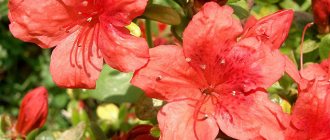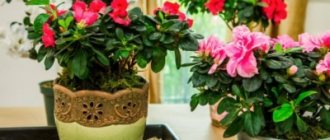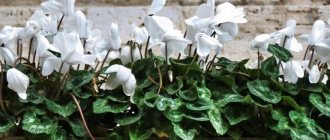Azalea is an amazingly beautiful perennial flower, which is especially interesting because it can bloom in late winter - early spring.
But, meanwhile, this is a houseplant that sensitively reacts to the slightest manifestations of uncomfortable care conditions. Therefore, achieving ideal growth and annual flowering can be difficult. Dear readers! For you, we have created communities on social networks in which useful articles and interesting ideas are published several times a day! Subscribe and receive useful content in a convenient format!
How to choose the right plant?
Tips for choosing Azaleas are about the same as for buying most indoor plants:
- It is preferable to choose a flower on which the first buds have just appeared. It is worth adhering to this rule first of all, since the plant in any case experiences stress when moving from its usual environment. But it was noticed that not in a blooming state, Azalea quickly adapts to new conditions.
- It is recommended to evaluate the external condition of the bush. To do this, it should be carefully tilted. If there are fading or even dry leaves at the base, then it is obvious that such an Azalea grew in an uncomfortable place. There is a risk that she will not survive the move and will quickly wither away.
Azalea in a pot
If you purchase a plant that is already flowering, then the only recommendation is not to try to immediately transplant it into a new pot. It is better to wait until the flowering ends or at least its peak. Otherwise, there will be very little chance of successful survival of such a magnificent flower.
Diseases of indoor azalea
Gray rot . It appears in the form of putrefactive spots on leaves and shoots, often with a gray “velvety” coating. The affected tissues soften and die, and over time the entire plant dies. The cause of gray rot is poor care and improper watering.
For treatment, all rotten parts of the plant are removed, and the soil in the pot is dried. It is advisable to treat the plant and soil with fungicidal preparations that do not contain chlorine and lime - these can be the biological preparations Fitosporin-M or Fitolavin, or a universal chemical fungicide, for example, Fundazol (5).
Root rot. Most often it appears due to excessive watering and stagnation of water in a pot or tray. Leaves wither throughout the plant, shoots become lethargic and may droop and lie down. The exact cause of the problem can only be determined by removing the plant from the pot: blackened, slimy, easily separated roots become visible.
To save the azalea, such roots are removed, the root system is soaked in a solution of potassium permanganate or a fungicidal preparation, then the plant is transplanted into new soil. Even if treatment is started on time, the azalea's chances of surviving the onset of root rot are slim.
Late blight . A dangerous disease of indoor azaleas, which is not always curable. The first signs are brownish spots with a light border on the leaves. Over time, they increase in size and parts of the plant begin to die off.
It is possible to save an indoor azalea infected with late blight in very rare cases. To do this, the affected parts are removed, the plant is treated with fungicides (Consento, Revus, Ordan (5)) and transplanted into new soil.
Chlorosis . The leaves turn pale and discolored, first between the veins, then throughout the entire leaf blade, dry out and die. The cause of this disease is not infection, but insufficient soil acidity. This happens, for example, when watering with unsettled or very hard water.
The problem is solved by adding lemon juice or citric acid to the water for irrigation; in severe cases, you will have to replant the plant in fresh soil with sufficient acidity.
Caring for Azalea after purchase
If you follow all the rules, namely, purchase an Azalea with barely visible buds, then it is better not to delay replanting it in a new permanent pot. In the future, you can adhere to the rules of transplanting young bushes into larger containers every year, and grown plants - every 2-3 years.
After the first preparations, all that remains is to find the ideal location for Azalea and try to avoid sudden changes in temperature, humidity and light.
Pests of indoor azaleas
The indoor azalea flower is affected by the same pests as other indoor plants: spider mites, scale insects, aphids, whiteflies and thrips.
If there are few pests, washing the plant with green soap helps; in extreme cases, you can use household soap. The procedure is repeated 2-3 times at intervals of several days.
In case of severe infestation of aphids or whiteflies, the plant can be treated with Actellik or Fitoverm; for spider mites, scale insects and thrips, Aktara is recommended (5). If the azalea blooms at this time, the flowers will have to be sacrificed: after spraying with the preparations, they will lose their decorative effect.
Growing conditions
Incomparable and abundant flowering - that's all about Azalea. It is even more pleasant because it comes very early, at the end of February - beginning of March, when winter in most parts of Russia does not even think of letting up. But in order to achieve the appearance of beautiful flowers, you will have to try.
Azalea is a very demanding houseplant. Even minor temperature fluctuations or failure to comply with the frequency of watering can lead to disruption of flowering rhythms, and sometimes even destroy the flower.
Temperature
Azalea notices temperature fluctuations of even 5-10°C. The main feature is that this flower does not like heat at all. During flowering, for example, it is not recommended to place the pot in a place where the air heats up above +18-20 C. Otherwise, even if it is possible to achieve flowering, it will most likely be fleeting and dull.
Optimal temperature for azaleas
Advice! Experienced gardeners recommend choosing a permanent place for Azaleas between two glasses - one will block access to cold air from the street, the other will block access to too warm air from the room. A balcony or veranda is best.
Another feature of this flower is that when the buds appear, it is important to reduce the air temperature even more, to about +12 °C. The upper limit is +18 °C.
In the summer, when it is very hot outside, to reduce stress, it is generally recommended to move the plant to a room where there is air conditioning (but not under direct flows of cold air).
Air humidity
The natural habitat of some varieties of Azalea is the humid tropics. This means that the plant loves high humidity, and this requirement should be strictly observed.
Attention! Particular attention should be paid to moisturizing the flower during the heating season, because hot radiators dry out the air greatly.
Azalea loves high humidity
, but you have to walk a fine line. Azalea is very capricious, so it will react equally poorly to both excessive waterlogging and excessively dry soil in a pot.
In general, you should have a regular sprayer on hand, with which you can give Azalea a light shower with cool water at least once a day. But don't forget about one more feature.
If the plant is blooming, then such procedures should be canceled, because droplets of water falling on the petals will lead to the formation of dark spots. To avoid this, during flowering it is better to simply place containers of water next to the pot, which will gradually evaporate.
Advice! You should avoid the popular misconception that to cool your azalea, you can try periodically placing pieces of ice on the surface of the soil. The root system of the plant in such conditions will be stressed and rot.
Flowering and what to do if it doesn’t bloom?
The flowering period varies from 2 to 6 months. Lasts from December to March. It happens even until April. In most cases it blooms very luxuriantly and abundantly. Flowering may not occur for the following reasons:
- The flower is kept in too warm conditions.
- The soil does not receive the necessary nutrition.
- The flower is in the open sun or in a too dark place.
- No pruning or pinching was done.
In this case, it is necessary to determine the reason for the lack of flowering and correct it.
Lighting
The main feature of Azalea lighting is due to the fact that it does not like heat. In its natural environment, it thrives in shady places where there is enough light, but where direct sunlight simply cannot penetrate.
Azalea loves light, but can't stand heat
Therefore, it is desirable to recreate the same conditions in an artificial environment.
- It is necessary to find a place where there will be enough light, but where the sun will either not look at all, or only hit in the morning or evening hours.
- The same can be said about those situations when Azalea is taken out into the open air. For example, at the dacha, the plant can be left in a shaded place under the trees in the garden, where the aggressive midday sun will not reach.
- At the same time, Azalea will not have enough light in October-November, when the buds of future flowers are set. Then you can’t do without fluorescent lamps.
We can say that Azalea is demanding in terms of lighting and is most capricious in this aspect. Therefore, finding a suitable place can be problematic, but it must be done.
Choosing a place to put it
Azalea on a table in the back of the room
When the question of choosing a place for Azalea arises, the intensity of sunlight should be put first, and only then the temperature.
The flower will feel good on windowsills where there is little sun. For example, windows facing west or east would be an ideal option. Usually the rays of the rising or setting sun cannot harm the delicate leaves of the plant.
You'll also have to think about temperature. It is true that even a slight discomfort that an Azalea will experience due to too high or too low a temperature will definitely lead to less than ideal and less long-lasting blooms.
Therefore, it is better to give preference to well-ventilated, shady rooms. It is very good if there is air conditioning in the room.
The balcony is also well suited for this heat-loving flower. But only if it does not face the south side.
Azalea on the windowsill
What does it look like in the interior?
Azalea belongs to the genus Rhododendron, which literally translates as “rose tree”. This is the distinctive feature of Azaleas - bright flowers of pink or red.
Externally, this plant is a neat bush that rarely exceeds 50 centimeters in height. Because Azaleas have very small leaves, they are almost invisible when the flowers bloom, occupying most of the plant's volume.
Undoubtedly, Azaleas will decorate a balcony or a not very hot window sill, because during their flowering season, when there is snow outside, they will remind you of the imminent approach of the long-awaited spring.
What it is?
Brief biological description
According to its description and characteristics, azalea is classified as an evergreen shrub, the height of which varies from 50 to 150 cm. Its scientific name is Azalea. The flowering period depends on the plant variety. It is abundant and the flowers are large. They have different colors.
What does a houseplant look like?
The elliptical leaves of the plant are small in size.
They are dark green in color, slightly shiny on top and very soft to the touch. Most often omitted. The flowers have a tubular funnel-shaped or flat shape. They form on the tops of last year's shoots. Flowers can be either single or bicolor. The color can be very different. Flowers are:
- Simple - have about 5-6 petals and 5 stamens.
- Terry - they have a different number of petals, which can grow directly from the stamens.
- A flower within a flower has 112 petals, as well as a cup that forms the petals.
Certain plant varieties have a pleasant aroma.
Passport
Azalea belongs to the genus Rhododendron and the Heather family . There are about 1000 species of this plant. Azalea is a small shrub that blooms in indoor conditions in the winter.
Country of origin
Its homeland is Japan and China. In the natural environment it is also found in North America, as well as in the southern part of Europe.
How to care at different times
Since it is already clear that Azalea reacts sensitively to even minor temperature fluctuations, the change of seasons can greatly affect the growth of the flower. It is important to try to maintain a balance and surround the plant with approximately the same conditions throughout the year. Sometimes you will even have to move the pot from its usual place.
Spring
The beginning of spring is the time of flowering of Azaleas. These days, it is recommended to pay special attention to watering and light spraying with cool, settled water. And be sure to remove any drops from the petals, because otherwise they will become covered with ugly spots.
Azalea must be sprayed with settled water
In spring, and then in summer, Azalea should be fed more often than at any other time of the year. The intensity can be individual, but the most common option for fertilizing is once a week. Preference should be given to those mineral supplements that are rich in potassium and phosphorus.
Azalea blossom
Summer
Summer is, first of all, the time for propagation of Azaleas by cuttings. It is important to choose shoots with buds that have not yet become woody. It is best to give preference to one-year-old shoots.
To ensure that the cuttings take root, it is better to cover them with a bag or glass jar and do not forget to water them well.
The secret of proper care in summer also lies in the need to remove the flower from particularly hot places. It is often advised to move the pot to a room where there is air conditioning or at least the windows face north.
Autumn
If conditions for Azaleas are ideal or close to such, then flowering can continue even until autumn. But usually already in July-August the last flowers fade, and the plant begins to slowly prepare for winter.
At this time, it is recommended to gradually reduce watering , eventually reaching the minimum annual values. You just need to make sure that the soil always remains moist, but not soggy.
Towards the end of autumn and the beginning of winter, you need to keep the flower in a temperature background of +10-12 C. It is believed that such conditions are literally the best for laying the strongest buds, and then the longest flowering.
Winter
The main problem with growing Azaleas in winter is the lack of light. To solve this, artificial lighting is used. And it is especially important to do this when the first buds - future flowers - appear on the plant.
The second feature is the need to strictly observe humidity and temperature, which change due to heating radiators that dry the air or greatly heat the room. Therefore, it is often recommended to even protect the flower pot with screens from the side of the room or choose a place where no more than +18-20 C is stably maintained.
What can rhododendron suffer from, and what pests can attack it?
This type of plant is quite susceptible to attack by a wide variety of pests, among which it is worth noting:
- Azalea moth
An unusual pest that damages azalea leaves, after which they begin to dry out and soon crumble. Adult pests move onto healthy leaves, forcing them to curl into tubes, where they can continue to grow until they are dealt with.
- Greenhouse whitefly.
It also attacks foliage, leaving sugary secretions on it, where the sooty fungus lives. This pest can carry some diseases that are dangerous to many indoor plants.
- Greenhouse aphid.
Aphids live in large groups, so if they attack a plant, most of the leaves on the bush are curled. In addition, due to this pest, the development and growth of the plant may be delayed.
- Greenhouse thrips.
If a plant is attacked by this parasite, then all its leaves will be covered with brown spots or black dots.
- Strawberry mite.
It is the most dangerous pest capable of attacking this flower. Only the leaves that appear are not even, but take on the appearance of a boat. Not just a few large healthy buds appear on the plant, but many small ones. Leads to a slowdown in plant growth and subsequently to its death.
- Flat red tick.
It can damage both cuttings and queen cells, as well as adult plant bushes. Leads to browning, wilting and shedding of leaves.
The most common way to combat any parasites is to wipe the leaves with a soapy sponge, as well as treat them with solutions designed to combat certain pests.
These plants, like no other, are susceptible to some kind of illness.
Diseases can be:
- powdery mildew
- chamois rot
- rust
- fusarium, etc.
In order to deal with them, you need to purchase the appropriate preparations and treat the azalea with them, according to the recommendations.
Transfer
Replanting a domestic azalea
It is important to replant an azalea immediately after purchase. But only if it has not yet bloomed.
One of the conditions for replanting is to take a pot at least 5 centimeters larger than the previous one each time. Experienced gardeners also recommend maintaining certain time intervals:
- For young plants, replant every year, approximately in the spring, but most importantly, not during the flowering period and not in winter.
- Adult plants are replanted less frequently - once every 2-3 years.
Each time you should carefully inspect the bush and do not be afraid to remove dried or fading shoots, leaves, and roots from it. On the contrary, it is even welcome.
How long does the period of bud opening last at home and on the site?
Many gardeners who are collectors of this plant variety successfully stimulate the setting of buds. When they say that flowers appear over the course of two months, they mean the gradual death of some buds and the formation of new ones. Without attempts to prolong the flowering process, it will last for two weeks, but with constant monitoring, budding reaches 2-2.5 months.
After the bud has bloomed, it is carefully removed, which allows the flower to concentrate its energies on the formation of a new bud. In order for the flower to bloom actively and profusely, proper pruning is required , which is carried out during the resting period of the azalea.
Landing
There are several tips for planting purchased Azaleas. Some recommend moving the plant along with a lump of earth. Others claim that there is nothing wrong with soaking the roots and removing all the soil from them before planting.
In any case, it is better to adhere to the following recommendations:
- Add Kornevin each time to stimulate growth and reduce plant stress.
- Plant only after flowering, first removing all dry shoots and leaves.
You can also use purchased soil (any kind for rhododendrons). It is only important that the soil is acidic, with a pH level of 3.5-5.
Advice! After planting, you do not need to water the Azalea for at least 3 days. And only then gradually return to normal hydration rules.
Reproduction
The most common way to propagate Azaleas is by cuttings. To do this, choose young shoots that have not yet become woody. They are separated from the main trunk and planted in the ground. When the first shoots appear on them, they are pinched, forming the crown of the future flower.
Azalea propagation
Sometimes the branch method is used for propagation. To do this, the lower shoots are already selected and carefully taken to the ground. Part of the stem is buried and wait for roots to appear (usually takes at least six months), and then the seedling is separated and transferred to another pot.
Trimming and pinching
Pruning and pinching Azaleas is an important step that is necessary to give the bush the correct shape, as well as abundant flowering in the spring.
A small pruner or garden shears will do the job. It is important to pinch young shoots first and then carefully cut them off. This way you can direct more of the plant’s energy to forming inflorescences.
At the end of April - May, all young shoots should be cut off at the end so that buds of future flowers are formed in this place.
After flowering, Azalea is prepared for wintering. To do this, all fading leaves, flowers and shoots are removed.
Azalea pruning
When and how to prune an azalea
If you want the plant to grow and develop properly, you need to trim unnecessary shoots at a certain time, as well as pinch some of its stems. As a rule, pruning of the plant should begin in early May.
Remember, the splendor of the bush determines how many flowers it will produce. The more foliage you leave, the fewer buds will form.
Be sure to remove all weak and elongated leaves.
All last year's stems must also be shortened.
Thanks to pruning, you can form a healthy and luxurious bush. In order to prune the plant, you need to stock up on sharp pruning shears, wiping it with alcohol in advance. To prevent infection from entering wounds.
Rejuvenation
The first rejuvenation of the plant can be carried out after 3-4 years of cultivation, when the peak of flowering of the bush has passed.
Under no circumstances should you start the process before or during flowering, otherwise you can destroy the entire bush. And since flowering normally continues until the end of spring, Azalea should be rejuvenated at the beginning of summer.
The main condition is to remove the longest or thickest shoots. Of course, weak, dried out, withering stems are also pruned.
Also, during transplantation, a similar procedure should be carried out with weak roots. This action will make the bush especially fragrant and renewed.
What is his process timeline?
Depending on the flowering time, there are 3 groups of domestic azaleas:
- Early (bloom in November-January).
- Medium (bloom in January-March).
- Late (bloom in March-April).
If you plant a home azalea in open ground areas in the summer, you can see it bloom twice a year. To do this, you need to prepare a special acidic soil. After planting, it should be cared for as a houseplant, and transplanted back into the pot in the fall.
Garden azalea, unlike home azalea, pleases with its flowering in the summer months. For lush flowering, it is necessary to trim and pinch the shoots in time , because the more magnificent the foliage, the sparser the plant will bloom.
Watering
Azalea should be watered frequently in summer, every 1-2 days, but with small portions of water. It is better to moisten the soil in small doses; water for irrigation must be settled and “softened.”
It won’t hurt to get a small sprayer and regularly lightly moisten the air and leaves for your Azaleas. But this procedure will have to be stopped during flowering, otherwise the flower petals can quickly be damaged.
In winter, the flower is watered a couple of times a week.
Spraying an azalea
Top dressing
It is best to feed Azalea with mineral fertilizers with a high content of potassium or phosphorus. But you need to be careful, because fertilizers with chlorine can destroy the plant.
For the flower, it is recommended to choose “Uniflor-bud” or “Kemira-Lux”. Excellent compatibility is expected with special mineral fertilizers from the “Azalea” series.
Most often, feeding is needed in spring and summer - up to weekly cycles. In winter, there is minimal intensity; it is enough to fertilize the flower once a month.
Pollination
One of the ways to propagate Azaleas is by seed. Flowers must be pollinated to produce seeds.
If there simply cannot be any problems outdoors, then at home you will have to do pollination yourself. But there is nothing complicated in the process. A cotton swab or brush is ideal and is used to collect pollen from flower to flower.
If everything goes well, then seed pods will appear later, from which you can collect enough seeds.
Diseases and pests
Leaf of an azalea affected by pests
Azaleas often experience leaf loss. The reasons may be either improper watering (both insufficient and excessive), or exposure of the leaves to the sun (then burns occur, and then the greenery dries out).
Among insects, Azalea is favored by spider mites and moths. You can combat them by treating them with soapy water or Bordeaux mixture.
Useful video:
Possible problems
If your home azalea is not cared for correctly, it may experience problems such as:
- Flying leaves . The plant suffers from a lack of moisture or the air in the room is excessively dry.
- Yellowing of foliage . The substrate is not acidic enough.
- The plant blooms sparingly . It feels an acute lack of nutrients, it is not pruned in a timely manner, or the room is too warm.
- Dry spots on leaf blades . These are sunburns.
- Elongated spots of a light shade appear on the foliage . There are leaf roller larvae on the bush.
- The color of the buds is green, the development of flowers is not observed . There is stagnation of moisture in the soil mixture or the bush is in a draft.
- The color of the buds is chestnut, the foliage is wilting . Too little watering + the room is very warm.
- Pests . The most common insects that inhabit the crop are mealybugs, azalea moths, thrips, spider mites, whiteflies and strawberry red mites.
How to resuscitate
In general, Azaleas are very capricious not only to the conditions surrounding them. If a flower begins to die, it is almost impossible to save it. Even if we correct ourselves and recreate the ideal microclimate, it will most likely be too late.
In case of sudden wilting, we can only advise saving some of the most surviving shoots by transplanting, for example, to another place. And after that, understand the cause of the problem and try not to repeat it.
And new shoots will grow quickly. With proper care, you can achieve the first flowers as early as next year.
Common mistakes
There are several of the most common mistakes that inexperienced gardeners make:
- Azalea is bought for an apartment where it is impossible to find a cool place for it.
- They prune the flower during flowering, but do not prune the plant after each flowering.
- Spray the flowers with a spray bottle.
- Do not change the location of the pot at different times of the year.
- The bush is rarely replanted.
If you try to understand the basic conditions that Azalea values so much, then the annual flowering will be long, and the plant will feel good and delight with a fresh, fragrant appearance at any time of the year.
Types and photos
It is customary to distinguish 2 main types of plants, from which subspecies originate:
- Indian azalea - it has luxurious funnel-shaped flowers, the size of which is 3.5 cm. The shoots are covered with bristles.
- Japanese - it is characterized by glossy leaves. The diameter of the flowers is 3 cm. It is a recognized national plant in Japan.
Next in the photo you can see what a rhododendron looks like in a pot in an apartment, what color it comes in, and there is also a full-length photo of the plant at home.
Answers to popular questions
Why doesn't it grow well?
The reasons for poor growth most often lie in the lack of proper lighting. Perhaps the whole problem will go away if you add artificial light.
The problem may also lie in the fact that Azalea is not happy with the pot in which it is planted. Since the flower has a rather weak root system, it does not like deep containers or deep planting.
Finally, you should be more careful about watering. Apparently the plant does not have enough moisture. And don’t forget about periodic feeding. If in the cold season they are rare (once a month), then in summer and spring fertilizers should be applied more often: at least once every 2 weeks.
Why doesn't it produce new shoots?
In almost all cases, new shoots do not grow because the Azaleas are simply cramped in the pot. This flower loves space very much, so the container for it should not only be shallow, but also wide enough.
Azalea also does not grow well because it lacks moisture. In this case, we can recommend leaving containers of water next to the pot, which will gradually evaporate and humidify the air.
How often does it bloom?
If all conditions are met, the Azalea is ready to bloom every year, and the inflorescences can last up to six months.
It is believed that the peak of flowering occurs in the 3-4th year of the plant’s life. If you prune the bush correctly, the number of flowers can be especially large.
Azalea's dormant period
Dormancy for an indoor flower occurs after transplantation; it lasts from May-June to November-December. Typically, flower crops are left untouched throughout the sleep phase, but this does not apply to rhododendrons. The rest period is used to apply regular fertilizing. Mineral complexes with a high content of phosphorus, nitrogen and potassium are suitable for this. Fertilizing is applied at the root weekly.
Special complexes that are created for this species are used at different stages of development:
- Before flowering, Zircon is added. It stimulates budding and development of the root system.
- Foliar feeding is carried out with Epin solution. It cannot be used during active growth or budding.
- With active development and establishment of shoots earlier than planned, Ferovit is applied. This remedy is rich in iron and can stop the start of exiting the resting phase too early.
Warning! When dissolving special complexes, carefully monitor the concentration. An excess of base substance can burn the roots.










